Optimus G - 720p flagship
It so happened that they gave me the Optimus G. test. Apparently, I liked my Nexus review . The device stayed with me a sufficient amount of time to realize the pros and cons, to see the strengths and weaknesses, to understand whether it is worth it, and generally get used to the device. Do without comparison with its direct relative will be difficult, and if you have not read the material on the Nexus 4 - read. So, what can the LG flagship offer, and what makes it different from other 720p devices?
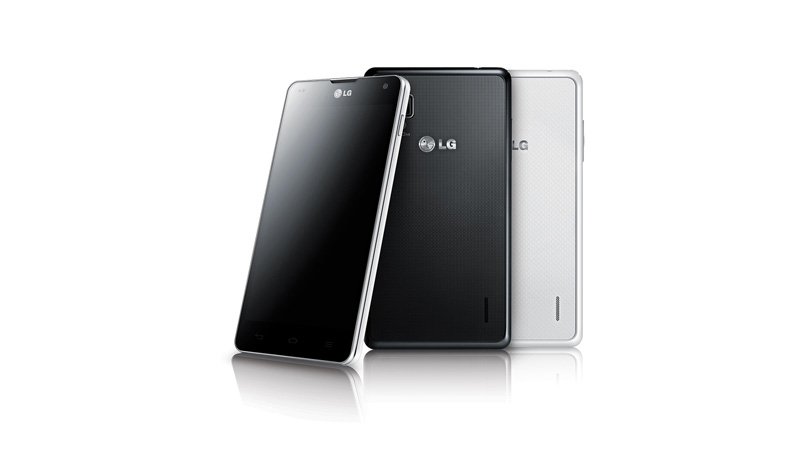
Design and ergonomics is a personal thing, but some common approaches always sooner or later begin to dominate the market, and manufacturers often have to rely on the average equestrian and spherical user in a vacuum. The location of the buttons, thickness, weight, and diagonal of the screen are born from this “user”. In this case, everything is more or less classical, there was no idiotic type of power button on the left side or in the upper-left corner.
The approach to the design of the design itself Optimus G directly resembles the already considered Nexus. Materials, characteristics, overall dimensions and, in general, the very concept of “mass production” dictates certain requirements for unification.

')
The front and rear panels are covered with glass (Gorilla Glass II, so far without it), silver edging, plastic sidewalls. The differences are in shape and some elements. As for the other devices of 2012 - Galaxy S III, HTC One X and Sony Xperia TX - then their appearance has its pros and cons.
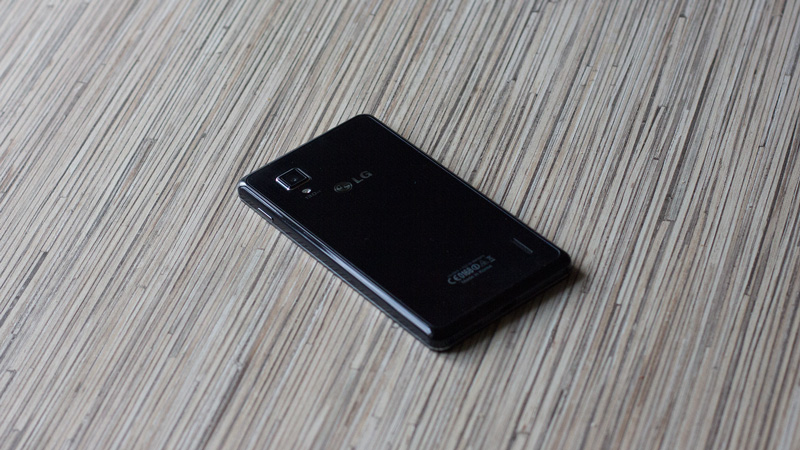
About S III, I already wrote a review in my time, and I had a device that half a year. Although the case caused (causes) complaints in terms of materials, it has two pleasant bonuses: it is practical (not afraid of falls and scratches), it can be disassembled, it allows you to replace the battery with an extended one or install the back panel with a cover-book like the S IV. On the other hand, glossy plastic is glossy plastic. After half a year of not the most negligent attitude, he covered himself with micro-scratches and chips. Where are they from - a mystery, the smartphone never fell seriously.
HTC One X is a matte and neat device, more resembling the S III in appearance than we would like. At the same time, it is deprived of half the advantages of the third galaxy - the housing is not collapsible, you can’t put the extended battery, and Tegra III eats the battery with a large spoon. To be honest, not one HTC since the days of the legendary HD2 has interested me so much that I want to buy it. Is that fresh One, but it costs some irresponsible money and is not going to get cheaper, besides, I have a Nexus. And it just so happened that I personally know Flagman 'a comrade, and poked his brand-new One. No, the model is cool, I do not argue, and it turns on in six seconds, but the hardware and touch buttons (their materials, location, tactile sensations) are beyond reasonable limits.
Xperia TX - neat and nice “brick” with a concave lid, neat lines and an unusual arrangement of keys. The lock is on the left, the volume is on the right, and at the bottom of the right side is the camera shutter button, which is rare now. Looks good, in my opinion, Sony has never had any problems with design at all.
Well, about the iPhone, I do not want to say anything here. IPhone it and in Africa iphone, with its small screen and peeling paint from the back panel, made of aluminum. I do not like iPhones.

Optimus G - a smartphone with a “brick” build, the corners of which are smoothly rounded with a small radius. Someone more like the rounded shape of the Google Phone, someone - a strict appearance Optimus'a, but to call a smartphone ugly or cheap-looking language does not turn anyone. It looks expensive, in the hand lies well, what else is needed?
The main elements that stand out are the edging and the control buttons. There's nothing to say about the edging - a thin frame under chrome looks nice and dilutes the “dull” black design of the smartphone. But the buttons ... the buttons are great. (Cobblestone in the HTC garden with their One'om). The texture and the course of both the volume and the locks are simply amazing: they are pressed and felt by hand very confidently, the first time and without any extra effort. There were no accidental clicks and triggers in my pocket. The appearance is complemented by both the design of the smartphone, and the excellent work of the buttons themselves: at the right moment they are under the finger, when not needed - they are almost not visible. The long-forgotten sensations of perfectly made hardware buttons. Functional design taxis. After them, the Nexus buttons seem muffled. And from HTC One just want to lay brickwork.

Everything is modest on the front panel: touch “back”, “home” and “menu” - their location is similar to the buttons in the Android 4.x panel. Thanks to them, the active area on the screen has increased, and this is especially noticeable in the photo. To be honest, for the first time, I am glad that the central “home” was made touch: a hardware button would destroy the image of a holistic and monolithic device.
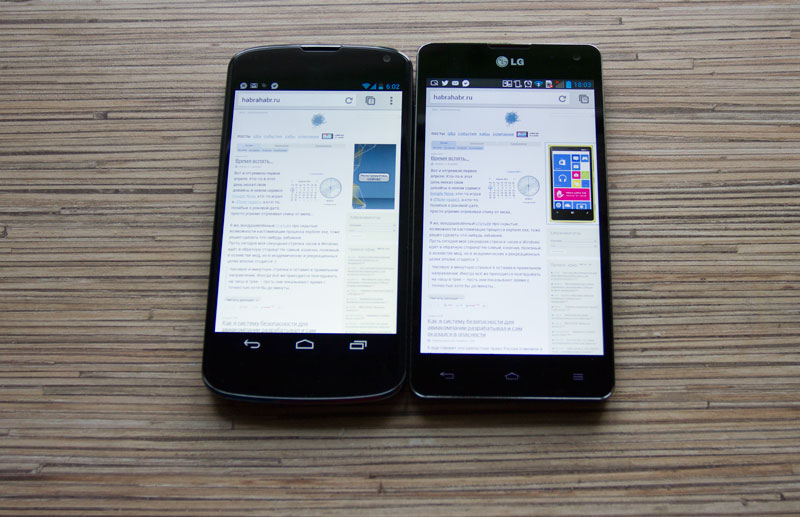
This solution also has a reverse side - it is much easier to reach the notification panel on the nexus - the screen is “shorter” due to the buttons that are missing below it: they are already located on the screen, and take place not under it, but on it. However, this minus is subjective and does not carry any negative thoughts, because more screen area = more content fit.
The only strange place in the structure of the phone is the camera module. It is “raised” above the level of the rear panel, clinging to everything. On the one hand, of course, this allows the smartphone to lie on the table, without touching the glass surface of potential crumbs and grains of sand that could damage Gorilla Glass (we are not afraid of a knife, but of course sand). In addition, the ringing speaker grid does not close tightly; if we place the Nexus on the table in the same way, the sound is muffled much stronger. Well, as a bonus - Optimus G does not suffer from “creeping disease” - does not seek to roll away from the minimum curve / inclined surface, if it lies with the screen up. What made it so highlight the camera on the background of the back panel is a mystery, perhaps, the module itself is larger than the analogous one in Nexus, and maybe this is just a design move.

From a technical point of view, there are not many differences in design and ergonomics either: SIM cards in the same micro-SIM format are inserted in the same way, the case is not collapsible, the battery is built-in, there is no memory card slot.
The processor, RAM and GPU here are the same as in the Nexus 4: It uses SOC Qualcomm Snapdragon S4 Pro with a clock frequency of 1.5 GHz, Adreno 320 and 2 GB of RAM. In the benchmarks, the device is ahead of the fourth nexus (mainly due to faster memory used to store files), and is one of the fastest devices in the overall standings, second only to some models of the 2013 FullHD generation. On the one hand, Optimus G conditionally refers to the “next-to-last” generation, on the other hand, the performance is so excessive that the difference in behavior between it and any device on Qualcomm 600 is zero in everyday life, and nobody will consider the protein coagulation.
Naturally, there are no problems with displaying the interface or games here, even though LG's proprietary shell and the lack of an upgrade to 4.2. Here are screenshots of benchmarks, I see no reason to comment on them:

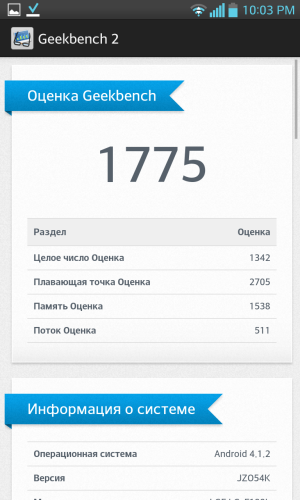
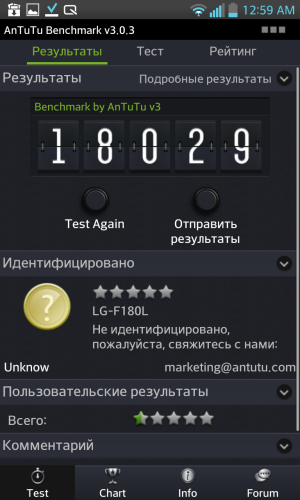

If you compare with classmates, the One X has a one-and-a-gigahertz Tegra 3 from Nvidia, its AnTuTu rating is about 10.5 thousand points. TX has only 2 Krait cores (against 4 for OptimusG / nexus 4) and GPU Adreno 255 (respectively, about 7 thousand points in AnTuTu). Performance can be described as sufficient, you will not see interface lags, but will the Android 5 (6?) Device get (and if it does, when), and how Android 5 or 6 will work on this hardware is the question.
Galaxy S III long enough was the king of ratings, knocking out 11-12 thousand in AnTuTu. Now it is inferior to Krait quad-cores (due to the architecture of Krait, which is closer to the Cortex-A15, rather than to the A9, on the basis of which the SoC of the third galaxy is built), but I will not decide to call it weak. Until now, a very decent machine, and the new OS versions come to it promptly.
The device comes in a single version - with 32 GB of flash memory on board. Memory cards are not provided. Yes, 32 gigabytes will be enough for someone, but this is not a reason to deprive the user of the opportunity to supply another 32, especially considering the fact that the iPhone 64GB exists, and Optimus does not. Yes, and there would be a reason to buy Optimus to those who are not catastrophically satisfied with the situation with the 16-gig Nexus.
The battery costs exactly the same as that of the Nexus, 2100 mAh, not replaceable. The characteristics are comparable with Nexus, but any LG's proprietary power-saving buns give an additional 10-15% autonomy, mainly reducing the battery consumption when the phone is idle or when the processor is not fully loaded (due to excessive processor performance, this situation occurs constantly, if you do not play on the phone all day long).
My beloved woman was dealing with issues of autonomy - she needs a smartphone for work, and she uses it to the fullest. Constant calls, Internet, mail, Skype, instant messengers, social networks, camera, transitions from 3G to WiFi and back, moving around the city by car and in the subway - in general, a typical case when the whole life of a person is tied to communications. Galaxy S III came home with a 5-8% battery, Optimus G - comes from 3-6% battery. That's just it does not recharge 40 minutes during the lunch break. So the autonomy of the device is excellent, especially since the issued corporate iPhone 5 (from which it refused) was discharged twice a day: to zero by 4 o'clock and up to 30-40% by the evening. Checkmate, cultists, believing the stories "android lives at the outlet."
The resolution is 1280x768 pixels, the TrueHD IPS + matrix (oh, these are marketers), the brightness is 400 nit and the same feature as in the last iPhone: no interlayer between the matrix and the protective glass in the form of a touchscreen, the sensor is built into the matrix module.
The display is very good, gives a bright picture, pleasant colors (in my opinion the picture is much better than that of conventional TN-monitors), excellent viewing angles. It is worth noting that the Koreans either greedy for Nexus, or decided to make Optimus G more “premium”.

The optimus screen is one of the best in its class: both in terms of color rendering, and in terms of brightness and contrast, and the viewing angles are excellent. Perhaps such a high-quality and juicy picture is the responsibility of the software settings (drivers, LG brand firmware, firmware) or the screen is good in itself, in hardware. Essentially, this does not change, Optimus G has one of the most pleasant-looking results. Of course, the screen is a bit blind in the sun, but I don’t know a single display that doesn’t use e-ink technology that would not lose contrast under the direct rays of a bright spring / summer light.
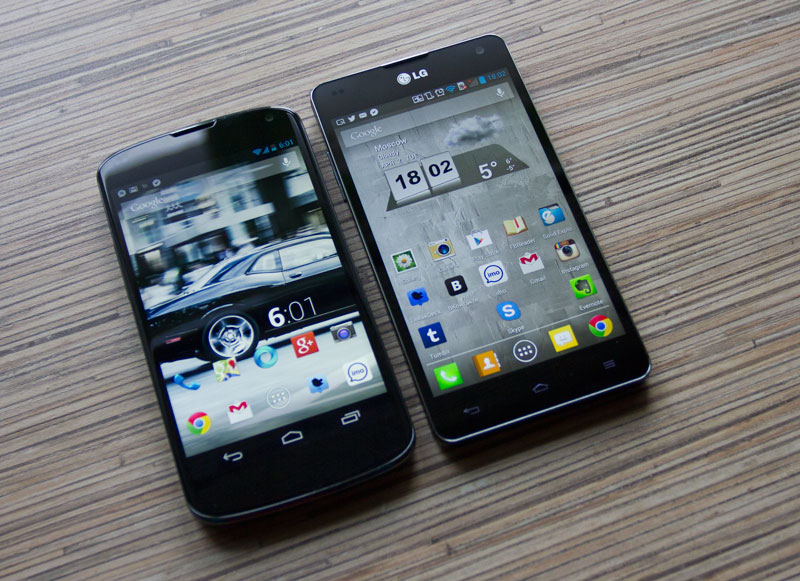
Well, it would be a crime not to compare the display with the Galaxy S III, about which I also wrote, and with which I was completely satisfied. AMOLED has its pros and cons, about which everyone probably knows, so here are the photos, here is a macro fragment, and let the spears be broken in the comments. Personally, I still like the crystal-clear black color of AMOLEDs, but in my opinion, the Optimus G image quality wins: both the clarity and the color rendition of G are clearly better.
Sony and HTC use LCD-displays, with not the best viewing angles and behavior in the sun. At least, I do not really like their behavior under the bright rays of the sun, and the viewing angles Tx and Z-ki did not scold just lazy, the Internet is full of cries on this subject.
Her pictures should speak for the camera, and I will give only short comments at the end of the section.
The camera perfectly shoots in the conditions of street lighting or normal home light, but it surrenders in the dark. Automatic white balance is often wrong; autofocus, though tenacious, clings to the wrong subject, the camera selects shutter speed and aperture settings strangely. The management itself after Nexus is difficult to call convenient, but the quality of the pictures at Optimus G is still different for the better.
Autofocus from the first or second time goes where it should and works faster than on the Nexus, the camera of which becomes helpless in the dark.
If, again, to compare with S III, then Optimus has better shots in favorable conditions, while Samsung has better shots. In addition, the S III is able to shoot in a series and is simply distinguished by the rate of fire for the better. Why was it necessary to push 13MPx into the phone - ask marketers if it would be better to increase the size of the sensor itself by 50% with the same eight. It’s still embarrassing to print this, but sending it by mail or social network is longer. With such a scanty resolution of the optics and the size of the matrix, it is time to stop, and begin a qualitative growth, not quantitative or quantitative growth, which leads to a qualitative, rather than to a marketing increase.
A serious disadvantage of the smartphone's camera is an unsolved problem with loud sounds on the video. She was already noted by me in the review of Nexus'a and did not go anywhere in Optimus'e, and shooting “concert” video on a smartphone, IMHO, is a very popular use of video mode in the phone.
In this regard, I was very pleased with the sound recording on the iPhone 5 (perhaps the video recording there was really good, despite the fact that the Foxconn breeders made a lot of effort to discredit the iPhone as a simple and reliable smartphone - then the microphones are dying, then cameras purple spots, then the paint peels off, then the assembly is creaking).
Unfortunately, in spite of the abundance of features and settings in the Optimus G camera, the convenience of managing the Nexus photography functions remains simply at the inaccessible level, use the stock application, or let users choose what to use.
At Habré, vendor add-ons on Android smartphones traditionally do not like (and there were reasons for the “dashing” times of Android 2.x), now all manufacturers realized that the brake shell is very annoying to users, and they go to watch another phone in the store (or choose another gadget in the web store, seeing the comments “slows down” to the product).
Optimus UI didn’t lose its branded chips, but I’ll probably write a separate sheet about it, because even a short overview will inflate the post to indecent sizes.
Very, very short: there is a built-in file manager (with all the necessary functions, including packing / unpacking zip archives), note software, task manager and application manager (allows you to remove some of the built-in software), a multilingual dictionary, Polaris Office, Dictaphone. The only thing that bothers me is the truly Asian love for ryushechkam, variegated and special effects. I hope that in a year or another LG will mature, and make the interface more concise and readable, as they did on HTC with their Sense. Especially noteworthy are the developers of icons and icons. Guys, in the yard in 2013, not 2007th.
Smartphone successful. The screen, autonomy, performance and appearance are commendable. LG is growing up, making confident devices, with its "twist", but still there is room to grow. We need to work on the camera, software (in terms of appearance and speed of updates) and accessories, and work diligently: competitors are not asleep.

To be honest, to part with the smartphone - sorry, the last time I had the feeling when I gave the test Galaxy S III. And if the device of the same generation evokes the feeling “sorry to part” with respect to the flagship, who also did not want to let go (and with respect to my favorite Nexus 4) - Optimus G can be called a really good smartphone. The screen is excellent, the case is well developed, not bad with autonomy, there are interesting moments in the software. Work with the community, actively correct errors, listen to the wishes of users, and they will respond to you with their devotion and money in your bank account.
If to compare with the third galaxy (devices, of course, belong to the 720p generation), then in the case of Optimus G there is a superiority in performance, body materials (in terms of appearance, practicality is a separate issue) and the overall quality level of the device assembly. On the side of the S III - the best camera of all the devices that I had (both in terms of shooting speed and shooting in difficult conditions), but a plastic case, a Pentile on the screen (some are a log in the eye), a design and a huge mountain of software of dubious utility. At LG, they are quietly removed by the native application manager.
Smartphone - successful. If I were offered right now to choose between the Nexus 4 and Optimus G - I would have thought very hard.
What else can I say about Optimus G? LG is growing. Appeared its design, expressive and not devoid of a sense of beauty. There are high-performance devices that are not ashamed to call the flagship. Balanced and not overloaded UI, albeit a bit strange in terms of working with several entities at a time. The device is not ashamed to use out of the box, and the box itself has ceased to resemble the packaging from a children's toy. There are also disadvantages: there is an excellent matrix in the device, which allows to get high-quality images, but it is killed by rotten software. It is time to get the design of icons, switches and other OS elements from 2010 and place them in 2013, making them modern and neat. Well, for spelling errors in localization (as well as the quality of localization itself) should be embarrassing. Russian keyboard would also be nice to pull up,On the US layout, there are punctuation marks, and the buttons are normally located, and ours were done according to the principle “and so it will come down”. It will not come down, work to bring it into a divine form - for 15-20 minutes, and the company - plus in karma.
I wonder when G pro will reach us?

Design, ergonomics and general appearance
Design and ergonomics is a personal thing, but some common approaches always sooner or later begin to dominate the market, and manufacturers often have to rely on the average equestrian and spherical user in a vacuum. The location of the buttons, thickness, weight, and diagonal of the screen are born from this “user”. In this case, everything is more or less classical, there was no idiotic type of power button on the left side or in the upper-left corner.
The approach to the design of the design itself Optimus G directly resembles the already considered Nexus. Materials, characteristics, overall dimensions and, in general, the very concept of “mass production” dictates certain requirements for unification.

')
The front and rear panels are covered with glass (Gorilla Glass II, so far without it), silver edging, plastic sidewalls. The differences are in shape and some elements. As for the other devices of 2012 - Galaxy S III, HTC One X and Sony Xperia TX - then their appearance has its pros and cons.

About S III, I already wrote a review in my time, and I had a device that half a year. Although the case caused (causes) complaints in terms of materials, it has two pleasant bonuses: it is practical (not afraid of falls and scratches), it can be disassembled, it allows you to replace the battery with an extended one or install the back panel with a cover-book like the S IV. On the other hand, glossy plastic is glossy plastic. After half a year of not the most negligent attitude, he covered himself with micro-scratches and chips. Where are they from - a mystery, the smartphone never fell seriously.
HTC One X is a matte and neat device, more resembling the S III in appearance than we would like. At the same time, it is deprived of half the advantages of the third galaxy - the housing is not collapsible, you can’t put the extended battery, and Tegra III eats the battery with a large spoon. To be honest, not one HTC since the days of the legendary HD2 has interested me so much that I want to buy it. Is that fresh One, but it costs some irresponsible money and is not going to get cheaper, besides, I have a Nexus. And it just so happened that I personally know Flagman 'a comrade, and poked his brand-new One. No, the model is cool, I do not argue, and it turns on in six seconds, but the hardware and touch buttons (their materials, location, tactile sensations) are beyond reasonable limits.
Xperia TX - neat and nice “brick” with a concave lid, neat lines and an unusual arrangement of keys. The lock is on the left, the volume is on the right, and at the bottom of the right side is the camera shutter button, which is rare now. Looks good, in my opinion, Sony has never had any problems with design at all.
Well, about the iPhone, I do not want to say anything here. IPhone it and in Africa iphone, with its small screen and peeling paint from the back panel, made of aluminum. I do not like iPhones.

Optimus G - a smartphone with a “brick” build, the corners of which are smoothly rounded with a small radius. Someone more like the rounded shape of the Google Phone, someone - a strict appearance Optimus'a, but to call a smartphone ugly or cheap-looking language does not turn anyone. It looks expensive, in the hand lies well, what else is needed?
The main elements that stand out are the edging and the control buttons. There's nothing to say about the edging - a thin frame under chrome looks nice and dilutes the “dull” black design of the smartphone. But the buttons ... the buttons are great. (Cobblestone in the HTC garden with their One'om). The texture and the course of both the volume and the locks are simply amazing: they are pressed and felt by hand very confidently, the first time and without any extra effort. There were no accidental clicks and triggers in my pocket. The appearance is complemented by both the design of the smartphone, and the excellent work of the buttons themselves: at the right moment they are under the finger, when not needed - they are almost not visible. The long-forgotten sensations of perfectly made hardware buttons. Functional design taxis. After them, the Nexus buttons seem muffled. And from HTC One just want to lay brickwork.

Everything is modest on the front panel: touch “back”, “home” and “menu” - their location is similar to the buttons in the Android 4.x panel. Thanks to them, the active area on the screen has increased, and this is especially noticeable in the photo. To be honest, for the first time, I am glad that the central “home” was made touch: a hardware button would destroy the image of a holistic and monolithic device.

This solution also has a reverse side - it is much easier to reach the notification panel on the nexus - the screen is “shorter” due to the buttons that are missing below it: they are already located on the screen, and take place not under it, but on it. However, this minus is subjective and does not carry any negative thoughts, because more screen area = more content fit.
The only strange place in the structure of the phone is the camera module. It is “raised” above the level of the rear panel, clinging to everything. On the one hand, of course, this allows the smartphone to lie on the table, without touching the glass surface of potential crumbs and grains of sand that could damage Gorilla Glass (we are not afraid of a knife, but of course sand). In addition, the ringing speaker grid does not close tightly; if we place the Nexus on the table in the same way, the sound is muffled much stronger. Well, as a bonus - Optimus G does not suffer from “creeping disease” - does not seek to roll away from the minimum curve / inclined surface, if it lies with the screen up. What made it so highlight the camera on the background of the back panel is a mystery, perhaps, the module itself is larger than the analogous one in Nexus, and maybe this is just a design move.

Iron and filling
From a technical point of view, there are not many differences in design and ergonomics either: SIM cards in the same micro-SIM format are inserted in the same way, the case is not collapsible, the battery is built-in, there is no memory card slot.
The processor, RAM and GPU here are the same as in the Nexus 4: It uses SOC Qualcomm Snapdragon S4 Pro with a clock frequency of 1.5 GHz, Adreno 320 and 2 GB of RAM. In the benchmarks, the device is ahead of the fourth nexus (mainly due to faster memory used to store files), and is one of the fastest devices in the overall standings, second only to some models of the 2013 FullHD generation. On the one hand, Optimus G conditionally refers to the “next-to-last” generation, on the other hand, the performance is so excessive that the difference in behavior between it and any device on Qualcomm 600 is zero in everyday life, and nobody will consider the protein coagulation.
Naturally, there are no problems with displaying the interface or games here, even though LG's proprietary shell and the lack of an upgrade to 4.2. Here are screenshots of benchmarks, I see no reason to comment on them:




If you compare with classmates, the One X has a one-and-a-gigahertz Tegra 3 from Nvidia, its AnTuTu rating is about 10.5 thousand points. TX has only 2 Krait cores (against 4 for OptimusG / nexus 4) and GPU Adreno 255 (respectively, about 7 thousand points in AnTuTu). Performance can be described as sufficient, you will not see interface lags, but will the Android 5 (6?) Device get (and if it does, when), and how Android 5 or 6 will work on this hardware is the question.
Galaxy S III long enough was the king of ratings, knocking out 11-12 thousand in AnTuTu. Now it is inferior to Krait quad-cores (due to the architecture of Krait, which is closer to the Cortex-A15, rather than to the A9, on the basis of which the SoC of the third galaxy is built), but I will not decide to call it weak. Until now, a very decent machine, and the new OS versions come to it promptly.
Memory
The device comes in a single version - with 32 GB of flash memory on board. Memory cards are not provided. Yes, 32 gigabytes will be enough for someone, but this is not a reason to deprive the user of the opportunity to supply another 32, especially considering the fact that the iPhone 64GB exists, and Optimus does not. Yes, and there would be a reason to buy Optimus to those who are not catastrophically satisfied with the situation with the 16-gig Nexus.
Autonomous swimming
The battery costs exactly the same as that of the Nexus, 2100 mAh, not replaceable. The characteristics are comparable with Nexus, but any LG's proprietary power-saving buns give an additional 10-15% autonomy, mainly reducing the battery consumption when the phone is idle or when the processor is not fully loaded (due to excessive processor performance, this situation occurs constantly, if you do not play on the phone all day long).
My beloved woman was dealing with issues of autonomy - she needs a smartphone for work, and she uses it to the fullest. Constant calls, Internet, mail, Skype, instant messengers, social networks, camera, transitions from 3G to WiFi and back, moving around the city by car and in the subway - in general, a typical case when the whole life of a person is tied to communications. Galaxy S III came home with a 5-8% battery, Optimus G - comes from 3-6% battery. That's just it does not recharge 40 minutes during the lunch break. So the autonomy of the device is excellent, especially since the issued corporate iPhone 5 (from which it refused) was discharged twice a day: to zero by 4 o'clock and up to 30-40% by the evening. Checkmate, cultists, believing the stories "android lives at the outlet."
Screen
The resolution is 1280x768 pixels, the TrueHD IPS + matrix (oh, these are marketers), the brightness is 400 nit and the same feature as in the last iPhone: no interlayer between the matrix and the protective glass in the form of a touchscreen, the sensor is built into the matrix module.
The display is very good, gives a bright picture, pleasant colors (in my opinion the picture is much better than that of conventional TN-monitors), excellent viewing angles. It is worth noting that the Koreans either greedy for Nexus, or decided to make Optimus G more “premium”.

The optimus screen is one of the best in its class: both in terms of color rendering, and in terms of brightness and contrast, and the viewing angles are excellent. Perhaps such a high-quality and juicy picture is the responsibility of the software settings (drivers, LG brand firmware, firmware) or the screen is good in itself, in hardware. Essentially, this does not change, Optimus G has one of the most pleasant-looking results. Of course, the screen is a bit blind in the sun, but I don’t know a single display that doesn’t use e-ink technology that would not lose contrast under the direct rays of a bright spring / summer light.

Well, it would be a crime not to compare the display with the Galaxy S III, about which I also wrote, and with which I was completely satisfied. AMOLED has its pros and cons, about which everyone probably knows, so here are the photos, here is a macro fragment, and let the spears be broken in the comments. Personally, I still like the crystal-clear black color of AMOLEDs, but in my opinion, the Optimus G image quality wins: both the clarity and the color rendition of G are clearly better.
Sony and HTC use LCD-displays, with not the best viewing angles and behavior in the sun. At least, I do not really like their behavior under the bright rays of the sun, and the viewing angles Tx and Z-ki did not scold just lazy, the Internet is full of cries on this subject.
Camera
Her pictures should speak for the camera, and I will give only short comments at the end of the section.
Photo:
Some of the photos are honestly stolen from other reviews, do not be angry, there was not much time, and there were no decent objects for photographing.




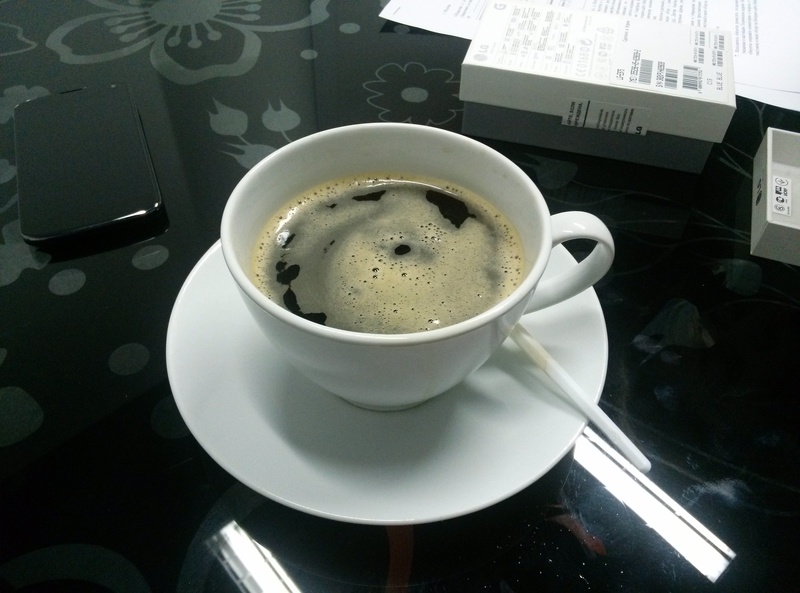





















The camera perfectly shoots in the conditions of street lighting or normal home light, but it surrenders in the dark. Automatic white balance is often wrong; autofocus, though tenacious, clings to the wrong subject, the camera selects shutter speed and aperture settings strangely. The management itself after Nexus is difficult to call convenient, but the quality of the pictures at Optimus G is still different for the better.
Autofocus from the first or second time goes where it should and works faster than on the Nexus, the camera of which becomes helpless in the dark.
If, again, to compare with S III, then Optimus has better shots in favorable conditions, while Samsung has better shots. In addition, the S III is able to shoot in a series and is simply distinguished by the rate of fire for the better. Why was it necessary to push 13MPx into the phone - ask marketers if it would be better to increase the size of the sensor itself by 50% with the same eight. It’s still embarrassing to print this, but sending it by mail or social network is longer. With such a scanty resolution of the optics and the size of the matrix, it is time to stop, and begin a qualitative growth, not quantitative or quantitative growth, which leads to a qualitative, rather than to a marketing increase.
A serious disadvantage of the smartphone's camera is an unsolved problem with loud sounds on the video. She was already noted by me in the review of Nexus'a and did not go anywhere in Optimus'e, and shooting “concert” video on a smartphone, IMHO, is a very popular use of video mode in the phone.
In this regard, I was very pleased with the sound recording on the iPhone 5 (perhaps the video recording there was really good, despite the fact that the Foxconn breeders made a lot of effort to discredit the iPhone as a simple and reliable smartphone - then the microphones are dying, then cameras purple spots, then the paint peels off, then the assembly is creaking).
Unfortunately, in spite of the abundance of features and settings in the Optimus G camera, the convenience of managing the Nexus photography functions remains simply at the inaccessible level, use the stock application, or let users choose what to use.
Software from LG.
At Habré, vendor add-ons on Android smartphones traditionally do not like (and there were reasons for the “dashing” times of Android 2.x), now all manufacturers realized that the brake shell is very annoying to users, and they go to watch another phone in the store (or choose another gadget in the web store, seeing the comments “slows down” to the product).
Optimus UI didn’t lose its branded chips, but I’ll probably write a separate sheet about it, because even a short overview will inflate the post to indecent sizes.
Very, very short: there is a built-in file manager (with all the necessary functions, including packing / unpacking zip archives), note software, task manager and application manager (allows you to remove some of the built-in software), a multilingual dictionary, Polaris Office, Dictaphone. The only thing that bothers me is the truly Asian love for ryushechkam, variegated and special effects. I hope that in a year or another LG will mature, and make the interface more concise and readable, as they did on HTC with their Sense. Especially noteworthy are the developers of icons and icons. Guys, in the yard in 2013, not 2007th.
findings
Smartphone successful. The screen, autonomy, performance and appearance are commendable. LG is growing up, making confident devices, with its "twist", but still there is room to grow. We need to work on the camera, software (in terms of appearance and speed of updates) and accessories, and work diligently: competitors are not asleep.
What can be improved?
- Camera. A good hardware base has already been achieved, but the software is still so-so.
- OS Where is 4.2 on the flagship device, completely similar in hardware to the same Nexus 4, for which the latest update has been on all smartphones for a hundred years now?
- Localization. Enough to use promt:


And spelling errors at the high school level are also bad. Only one "obnu facie" what is worth. (Catch in the screenshot failed).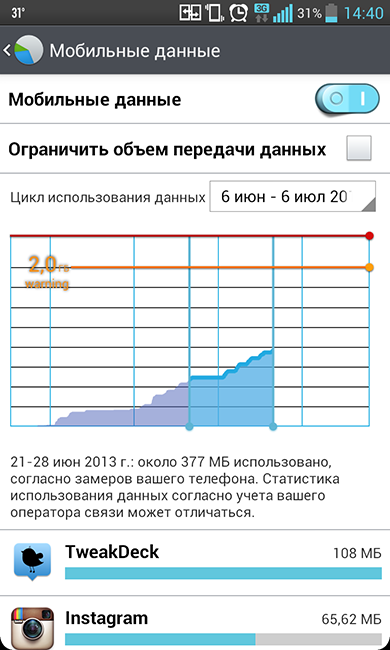
Remember, children, the preposition “according to” requires the dative case and asks the question “what” and not “what”. Here's your proof .
I myself will not observe these errors, my phones are all in English locale. But this is a banal disrespect for our market and our people, for whom Russian is their native language.
Yes, and with reductions from LG too trouble: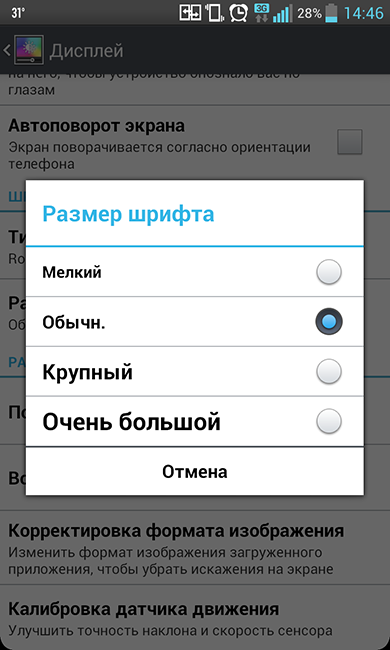

- Features. LG has a lot of interesting solutions in the field of Smart TV, and of all the systems of smart TV, I liked their development the most. One remote-pointer what is it worth? Why can not you think of something similarly cool for a smartphone? To introduce chips “like everyone else”, slightly changing the implementation or approach to one or another opportunity, of course, well, will not be reproached for “we have it, but you don’t”. But this is no reason to throw innovative ideas.
- Hardware and accessories. Where is the wireless charging dock? I have never seen them in online stores, not to mention ordinary ones. The benefit of branded accessories in the form of covers, bumpers and headphones are not cheated.

Aftertaste
To be honest, to part with the smartphone - sorry, the last time I had the feeling when I gave the test Galaxy S III. And if the device of the same generation evokes the feeling “sorry to part” with respect to the flagship, who also did not want to let go (and with respect to my favorite Nexus 4) - Optimus G can be called a really good smartphone. The screen is excellent, the case is well developed, not bad with autonomy, there are interesting moments in the software. Work with the community, actively correct errors, listen to the wishes of users, and they will respond to you with their devotion and money in your bank account.
If to compare with the third galaxy (devices, of course, belong to the 720p generation), then in the case of Optimus G there is a superiority in performance, body materials (in terms of appearance, practicality is a separate issue) and the overall quality level of the device assembly. On the side of the S III - the best camera of all the devices that I had (both in terms of shooting speed and shooting in difficult conditions), but a plastic case, a Pentile on the screen (some are a log in the eye), a design and a huge mountain of software of dubious utility. At LG, they are quietly removed by the native application manager.
Smartphone - successful. If I were offered right now to choose between the Nexus 4 and Optimus G - I would have thought very hard.
What else can I say about Optimus G? LG is growing. Appeared its design, expressive and not devoid of a sense of beauty. There are high-performance devices that are not ashamed to call the flagship. Balanced and not overloaded UI, albeit a bit strange in terms of working with several entities at a time. The device is not ashamed to use out of the box, and the box itself has ceased to resemble the packaging from a children's toy. There are also disadvantages: there is an excellent matrix in the device, which allows to get high-quality images, but it is killed by rotten software. It is time to get the design of icons, switches and other OS elements from 2010 and place them in 2013, making them modern and neat. Well, for spelling errors in localization (as well as the quality of localization itself) should be embarrassing. Russian keyboard would also be nice to pull up,On the US layout, there are punctuation marks, and the buttons are normally located, and ours were done according to the principle “and so it will come down”. It will not come down, work to bring it into a divine form - for 15-20 minutes, and the company - plus in karma.
I wonder when G pro will reach us?
Source: https://habr.com/ru/post/175217/
All Articles